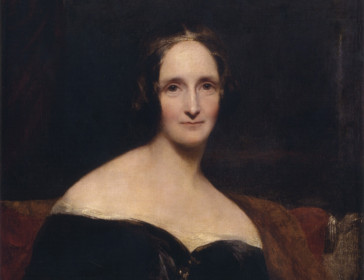Mary Wollstonecraft Shelley? Robert Walton? Victor Frankenstein? Apocryphal?

Question for Quote Investigator: Finding a goal or purpose to strive for in life is wonderfully helpful; uncertainty and anxiety are replaced by mental tranquility. Mary Wollstonecraft Shelley who authored the groundbreaking science fiction novel “Frankenstein; or, The Modern Prometheus” once made this point. Would you please help me to find citation?
Reply from Quote Investigator: Shelley’s “Frankenstein” begins with the text of a letter from the explorer Robert Walton to his sister. The fictional Walton is leading an expedition toward the North Pole while hoping to make a major discovery such as a navigable passage connecting the Atlantic Ocean to the Pacific. Boldface added to excerpts by QI:1
These reflections have dispelled the agitation with which I began my letter, and I feel my heart glow with an enthusiasm which elevates me to heaven; for nothing contributes so much to tranquillize the mind as a steady purpose,—a point on which the soul may fix its intellectual eye. This expedition has been the favourite dream of my early years. I have read with ardour the accounts of the various voyages which have been made in the prospect of arriving at the North Pacific Ocean through the seas which surround the pole.
The 1818 edition employed the spelling “tranquillize”. Variant spellings include: tranquillise, tranquilize, and tranquilise.
Walton’s crew discover a man on a sledge who is nearly dead. The man is nursed back to health, and Shelley switches the narration of the novel. The rescued man is the ill-fated scientist Victor Frankenstein, and he recounts the rest of the tale.
Below are additional selected citations in chronological order.
In June 1833 “The New-York Mirror: A Weekly Journal Devoted to Literature and the Fine Arts” found the quotation memorable enough to share with its readers:2
From Mrs. Shelly’s Frankenstein.
Resolution.—Nothing contributes so much to tranquillize the mind as a steady purpose—a point on which the soul may fix its intellectual eye.
In August 1833 the quotation appeared in “The Rural Repository” of Hudson, New York with one small alteration. The word “tranquillize” was changed to “tranquilize”.3
In 1986 “The Fitzhenry & Whiteside Book of Quotations” included the statement with an attribution to Mary Wollstonecraft Shelley.4
In 1990 “What a Piece of Work Is Man!: Camp’s Unfamiliar Quotations from 2,000 B.C. to the Present” included the statement with an ascription to Shelley and a citation pointing to “Frankenstein” in 1918.5
In conclusion, Mary Wollstonecraft Shelley deserves credit for this quotation. Her character Robert Walton penned the words in a letter that appeared in her famous novel “Frankenstein; or, The Modern Prometheus”.
Image Notes: Portrait of Mary Wollstonecraft Shelley by Richard Rothwell circa 1840. Image has been cropped and resized.
Update History: On March 27, 2025 the format of the bibliographical notes was updated.
- 1818, Frankenstein: Or, The Modern Prometheus by Mary Wollstonecraft Shelley, Volume 1 of 3, Letter 1, To: Mrs. Saville, England, Location: St. Petersburgh, Date: Dec. 11, 17–, Start Page 1, Quote Page 4, Printed for Lackington, Hughes, Harding, Mavor & Jones, London. (Google Books Full View) link ↩︎
- 1833 June 8, The New-York Mirror: A Weekly Journal, Devoted to Literature and the Fine Arts, Section: Gleanings, From Mrs. Shelly’s Frankenstein, Quote Page 392, New York, New York. (Google Books Full View) link ↩︎
- 1833 August 31, The Rural Repository, Resolution (Filler Item), Quote Page 55, Published by William B. Stoddard, Hudson, New York. (Google Books Full View) link ↩︎
- 1986, The Fitzhenry & Whiteside Book of Quotations, Revised and Enlarged, Edited by Robert I. Fitzhenry, Section: Wisdom and the Wise, Quote Page 368, Fitzhenry & Whiteside Limited, Toronto. (Verified with hardcopy) ↩︎
- 1990, What a Piece of Work Is Man!: Camp’s Unfamiliar Quotations from 2,000 B.C. to the Present by Wesley D. Camp, Topic: Purpose, Quote Page 281, Prentice Hall, A Division of Simon & Schuster, Englewood Cliffs, New Jersey. (Verified with hardcopy) ↩︎